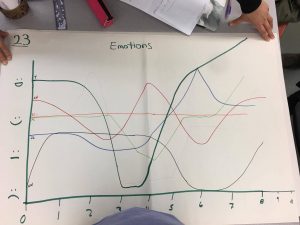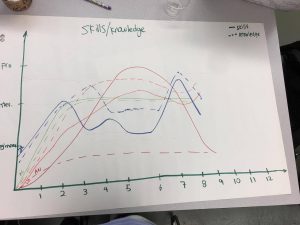Weekly Objectives and Achievements
| Weeks | Weekly objectives | Achievements |
| 7 | Next trip to the farmers markets to conduct surveys.
→ October 21st and 22nd. Finish question bank and formatting survey Survey questions need to be reviewed by Tara |
Questions have been approved by Tara and it looks like she likes our proposal and our project is pretty much formed.
Hard copy surveys have been distributed to vendors at Ambleside – table 1 Started data entry on excel Finalized our survey with necessary questions |
| 8 | Team working meeting – Cold call and email randomly selected vendors to complete survey
Finish data collection with physical surveys at remaining farmer’s market (Lonsdale) |
Online surveys are created
Email surveys have been sent to 434 vendors (have participated in the past / are participating in the market) in both Ambleside and Lonsdale locations – table 1 42 online responses received from vendors Start organizing online responses Data from hard copy surveys have been entered and organized Completed physical survey data collection at both Farmers Markets Started working on blog post 3 |
| 9 | Mapping moments of significance
Blog post due Finish data entry from all collected data Start analyzing data through ANOVA |
Submitted blog post 3
Reflection through completion of skills/emotion/knowledge graphs in tutorial Collected data are prepared for analyzation |
Achievements in detail:
Table 1. Number of surveys sent to vendors/responses received from vendors
| Type of Surveys | Locations | Number of Surveys
Distributed/Sent to Vendors |
Number of Responses from Vendors |
| Email (online) | Ambleside & Lonsdale | 434 | 42 |
| Hard copy | Ambleside | 20 | 19 |
| Hard Copy | Lonsdale | 8 | 5 |
Moments of Significant Change
During tutorial session, our group’s participation in the “Moments of Significant Change” workshop helped us reflect on working with the Artisan Farmers’ Markets and the process of experiential learning. First, we individually assessed how our emotions, values, beliefs, and attitudes have changed since week one. To do this, we set up a graph with the y axis as “stages of emotion” (sad, neutral, satisfied, happy) and the x axis as “weeks” (1 to 13). As one could expect, our individual emotions graph each had ups and downs in different weeks. However, upon combining our graphs into one collective group graph, as the second part of the workshops, it was clear that we experienced similar dips in our emotions during week 3 and 4. When discussing our reasons for feeling this way during those weeks, many of us expressed that uncertainty of where the project was headed played a key role. Furthermore, some of us felt frustration due to conflicting goals from the Artisan Farmers’ Markets and the course objectives. However, as the graph indicates, weeks 4 to 8 have been increasingly positive in terms of emotions for everyone in the group. As the group continued on and we received feedback from our project proposal, increased confidence within our group led to better attitudes and emotions within the group. We were very fortunate to have the Artisan Farmers Markets general manager, Tara, join us in tutorial this week and it was interesting to see how this experience has been so far from her perspective. It turns out, our group was able to share the same excitement with the Artisan Farmers’ Markets in terms of emotions after week 4. In fact, we felt like this workshop helped us bond with our community partner immensely through reflecting on our work so far and having the opportunity to celebrate our achievements thus far.
The Moments of Significant Change Workshop also allowed us to reflect on the development of our knowledge and skills since week one. Again, we set up individual graphs first with the y axis as “beginner, moderate, pro” and the x axis as “weeks” (1-13). After combining our individual graphs into a group graph, we saw some similar patterns. As indicated by the photo of the graph below, our group have experienced steady growth in knowledge and skills. During discussion, we all felt like visiting the farmers’ markets during week 3 and 4 was a significant experiential learning moment. It was interesting to share and witness how each group member gained something different from the experience. Despite visiting the same markets and talking to the same vendors, we all took home different knowledge and remembered different parts of conservations we shared with vendors. As far as skills development go, there has been a steady growth as well. However, the development has been slower than our growth in knowledge. Upon reflecting on this pattern, our group came up with one possible reason for this. Throughout the project, we have been utilizing individual’s’ strengths to complement for each others’ weaknesses. For example, if one group member’s weakness is blog writing, another group member will step in while the other member, who is weak a writing, can spend her/his time contributing to the project in a more productive way. Thus, we have limited ourselves in skills development in some aspects. With that being said, our group agreed that we have all developed teamwork skills throughout the project. This includes communication, attentive listening, problem-solving, and negotiation.
Moving forward, we have agreed that maintaining the upward growth for emotions will be crucial to our success for completing this project. Although a busy month is ahead of us, this tutorial workshop helped us reflect on the importance of keeping a positive attitude. In addition, we agreed to keep expanding our knowledge and skills by switching up some roles for the remaining weeks. We are excited to help each other out in developing and bettering our skill sets. Check out our graphs below!


Graceful Dismount
Over the past two weekends we split our team between Lonsdale and Ambleside to distribute the surveys we had worked with the Artisan Farmers’ Markets general manager to develop. After collecting as many surveys as possible in-person, we distributed electronic versions of the survey to current and past vendors via email. By the end of the month we will have analyzed our collected data and presented our findings to the organization. As this time approaches, we need to start thinking about how we can ensure that our project can be utilized and further developed for the future.
Our team is in a unique situation where, fortunately for the Artisan Farmers’ Markets, a new group of LFS 350 students will be taking on a similar project in 2018. Thus, we will be able to pass on our project to this new group without having to worry about whether or not our efforts will be abandoned. This reality gives us comfort, but also requires that we recognize our responsibility to ensure that our project is useful for the farmers’ markets general manager and for the new team of students when setting up their project to collect customer data in January.
In terms of an exit strategy with the Artisan Farmers’ Markets Society, there is not much we will be able to do to ensure that the work that we have done will be actioned by staff. However, we can ensure that the way in which we present our findings to the society is clearly actionable. We will try to make sure that we present our infographic and report with clarity and provide an analysis that combines reflections with recommendations. In this way we hope that the general manager will be able to use our report to guide her in developing the society’s next steps.
Similarly, we need to make sure that our report is also useful for the next student team coming in. These students will have access to all of our final results (infographic, surveys, blog, report) to help them shape the second part of the project. However, it would be best for us to develop a method to pass on how we got to where we did. To make sure this group can get off to the best start possible, we will make sure that our blog is reflective of every step we took during this community based learning project and that the general manager is also familiar with what methods worked and didn’t work for us. We hope that a deep reflective conversation with our community partner will help her to guide the next group to avoid the mistakes we did.
All in all, we have had a successful run so far and are excited to bring all that we have gathered together for our final presentation.
Strategies for a Graceful Dismount
Task 1: Find common themes from our interview data and connect the dots
Task 2: Work on group cooperation and communication
(Week 8-9)
-
- After transcribing recordings/interview responses, start categorizing data and look for supporting quotes that give the report credibility;
- Begin discussing commonalities among the compiled data for analysis that supports a conclusion and gives us the insight on next steps; and,
- Team working meeting – Cold call and email randomly selected vendors to complete survey
- Keep all group members engaged and participating when discussing trends.
(Ongoing)
-
- Ensure that all group members are informed and on-top of our research;
- Keep group members caught-up with new data entries, ideas, correlations, conclusions, and discussions; and,
- Keep up with deadlines to ensure the project is following the timeline and to resolve and obstacles that arise.